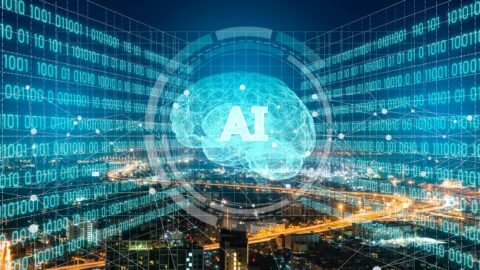Artificial Intelligence vs Machine Learning: the Key Differences
If you’re starting to familiarise yourself with the burgeoning world of AI research, then you might have come across two terms, the meaning of which might appear to be interchangeable. The first is ‘Artificial Intelligence’; the second or ‘Machine Learning’. What these terms mean is hugely important, so it’s worth dwelling on the distinction between artificial intelligence vs machine learning difference.
Table of Contents
What is AI?
While we all might think we have an intuitive grasp of what AI is, actually spelling it out is quite difficult. A number of competing definitions have been developed since the 1950s when Alan Turing developed his famous test. But for the most part, intelligence is something that’s capable of goal-oriented decision-making. Artificial intelligence is a machine that’s able to do this.

AIs come in different forms. A narrow AI is something that is very good at doing one particular kind of thinking. You might look at the calculator on your phone, which can perform arithmetic with superhuman speed and accuracy. Then there’s broad AI, which can do several different things. You might think of your voice assistant, which can not only recognize your commands. But also execute them by booking appointments, setting timers, and placing orders.
What is Machine Learning?
Machine learning is one process via which artificial intelligence can be created and refined. The most popular kinds use a kind of Darwinian approach, with hundreds of interactions progressively refining an algorithm using training data. The program is varied slightly with each iteration. And the variations which can perform the task better then form the basis for the following generation.
So, for example, we might develop machine intelligence that can race a virtual car around a virtual track: the cars that progress furthest, fastest, are taken and used to create a new generation of virtual cars, and in this way, the program is refined.

Human beings or unsupervised can supervise machine learning. Machine learning is a major component of attention-retaining websites like Youtube, Facebook, and Tiktok. The machine is constantly experimenting with users, and learning which psychological buttons to press. It’s for this reason that you might get different thumbnails on Netflix for your friends.
What makes Artificial Intelligence vs Machine Learning different?
If you’re struggling with the difference, it’s easy to just remember that machine learning is just one variety of AI. You’ll find other terms within the category of machine learning, too, like ‘deep learning’. To develop the sophisticated AIs of the future, software companies might well use a form of machine learning. But they might equally use any number of other techniques since machine learning has drawbacks that can go away by other approaches.
If you’re struggling to understand how modern AI technology might benefit your company, or how it might expose you to unforseen risk factors, then it might be worth bringing in professional help from specialised tech solicitors.
Artificial Intelligence vs Machine Learning Differences
One way to conceptualize machine learning is as a collection of algorithms that examine data. It also draw conclusions, and then act in accordance with those conclusions.
Learning through machines has the potential to automate a wide variety of operations. It has an impact on practically every sector. From the search for malware in information technology to forecasting the weather to stockbrokers seeking for the best possible investments. In order to obtain the functions and outcomes, machine learning necessitates the use of mathematics. As well as a significant amount of coding. Traditional algorithms operate in the machine learning process in order to complete a variety of tasks, including clustering, regression, and classification. These algorithms need to be trained on a significant amount of data before we can use them. Your model will get more accurate the more information you give your algorithm to work with.
Neural Networks:
The creation of neural networks has been crucial in teaching computers to think and perceive the world in the same manner that humans do. While at the same time preserving the inherent advantages that computers have over humans, such as their speed, accuracy, and absence of prejudice.
A Neural Network is a type of computer system aims to function in the same way as a human brain works by organizing information into categories. It can learn to detect things such as photographs. And then, organize them according to the components that they comprise.
There is no doubt that artificial intelligence, and specifically machine learning (ML) in this day and age, has a lot to offer. Every industry, from banking to healthcare to manufacturing, is seeing the benefits of artificial intelligence’s ability to automate monotonous jobs while also providing creative insight. Therefore, it is essential to keep in mind that AI and ML are not the same thing. Rather, they are products, and they are doing so consistently and profitably.
Machine Learning vs Artificial Intelligence in Future
The possibility presented by machine learning has unquestionably been pounced upon by marketers. Since artificial intelligence has been around for such a long time, it is possible that it has begun to be some sense “old hat,” even before its promise has ever been properly in effect. Along the path that leads to the so-called “artificial intelligence revolution,” there have been a few false starts. The term “machine learning” provides marketers with something fresh, shiny, and most crucially, firmly grounded in the here and now, to offer.
The idea that we will one day create artificial intelligence that is comparable to humans is sometimes presented by engineers as somewhat of a foregone conclusion. Undoubtedly, our proximity to the target is greater than it has ever been. And our rate of advancement toward it is accelerating. The revolutionary shifts in our conceptions of how AI operate. And they have been brought about by ML, are responsible for a significant portion of the fascinating development that has been made over the past several years.

11+ years strategic communications, marketing, and project management experience. I am a trainer at StarWood Training Institute, focusing on online courses for project management professionals.










